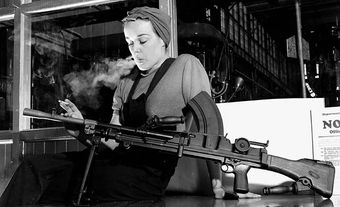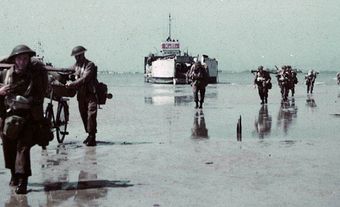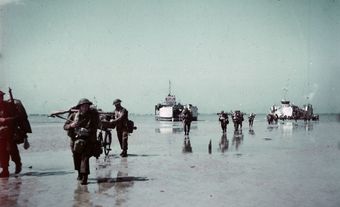The Bren Light Machine Gun (LMG) was an automatic weapon developed in Czechoslovakia before the Second World War. After modifications, British and Commonwealth armies adopted it as their primary infantry platoon support weapon. The Bren saw service with the Canadian Army from 1939 to the 1950s.
Background
In 1935, the British Army accepted a Czechoslovakian LMG as a replacement for their First World War-era Lewis Gun. The British made several modifications to the original design. They modified it to .303 calibre, changed the butt, barrel, magazine and gas block, and removed barrel-cooling fins. The guns were manufactured at the Royal Small Arms Factory in Britain and designated the Bren. The name was formed from the first two letters of the locations of the Czech manufacturer (Brno) and the Royal Small Arms Factory (Enfield).
Design
The Bren gun was gas-operated and air-cooled. It could fire in either semi- or fully automatic modes, using a distinctive top-mounted, curved 30-round magazine. The Bren had a quick-change barrel, which could be replaced in seconds to prevent overheating and barrel warping. This allowed it to keep up a sustained rate of fire. Theoretically, the gun could fire up to around 500 rounds per minute. On semi-automatic, it had an effective range of 550 to 730 m. During the Second World War, the original Mark I model underwent three major modifications, which differed largely in barrel length and weight.
Production
The British initially turned out 300 Bren Guns a week, which increased to 400 per week after the war began in 1939. By 1943, this figure had risen to 1,000 a week. John Inglis and Company of Canada began manufacturing Brens in 1940. By 1943, 60 per cent of all Bren Gun production took place in Canada.
Did you know?
A number of Canadian-made Bren guns in 7.92 mm calibre were produced for Nationalist Chinese troops.

Employment
Each of the three sections of an infantry rifle platoon carried a Bren gun. A section was divided into two groups: a gun group with the Bren and a rifle group. Most of the section was in the rifle group (usually eight soldiers), while the gun group consisted of two men. A Bren gunner (No. 1) carried and fired the gun and an assistant (No. 2) changed ammunition magazines and carried more loaded ones, usually in utility pouches. The No. 2 also carried a spare barrel and parts and a tool kit. Soldiers in the rifle group also carried additional loaded magazines. As well, each infantry battalion had a carrier platoon equipped with 13 Universal Carriers (commonly known as Bren Gun Carriers), each of which carried a Bren.

The Bren Gun was best fired from the ground using a bipod. It could also be fired less accurately from the shoulder or hip. Gunners usually fired on automatic, using two- or three-round bursts. Although normally employed in a ground support role, the Bren could also be used against aircraft. There were also special tripod anti-aircraft mounts for the Bren, which were usually coupled with a high-capacity drum magazine.
The Bren Gun was one of the most widely used light machine guns at the time. Many consider it to be the best machine gun of its type. Canada replaced the Bren with the FN C2 in the 1950s. (See FN C1 Self-Loading Rifle.)

 Share on Facebook
Share on Facebook Share on X
Share on X Share by Email
Share by Email Share on Google Classroom
Share on Google Classroom



